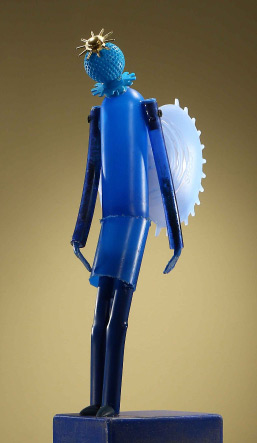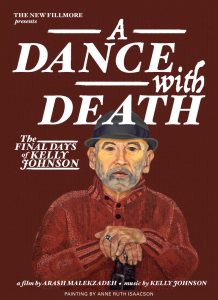ART & FILM | PAMELA FEINSILBER
Toward the end of Plastic Man: The Artful Life of Jerry Ross Barrish, we see Barrish, San Francisco’s most famous bail bondsman, at his 50th high school reunion. He is shocked to find most of his Lincoln High classmates retired — “playing golf or something” — while he is still in mid-career.
That’s a phrase you hear more often in an art museum, when an artist is given a “mid-career retrospective” of his work. And, in fact, Barrish is an artist himself. Now in his 70s, he has shut down his bail bond office across from the Hall of Justice. But he is only a little past mid-career in creating his detritus-based sculpture — what the Fresno Art Museum called “Art Drecko” in its exhibition of his found-art assemblages in 2008-2009.
Barrish creates figures of people and animals from castoff plastic and other junk he scavenges, and all of a sudden it seems he’s the man of the moment.
Two dozen of his plastic sculptures are on view in a new exhibition, Sculptures from the Plastic Man, at Studio Gallery on Pacific. And William Farley’s 75-minute Plastic Man documentary is part of this year’s San Francisco Jewish Film Festival, with screenings in San Francisco, Palo Alto and Berkeley.
Even so, while Barrish’s work can be found in the permanent collections of the Berkeley Art Museum, the Oakland Museum of California, Napa’s di Rosa Preserve and others, he is still waiting for his first major museum exhibition.
That’s the kind of “affirmation” — a word he uses often — he’s still looking for. Many critics consider abstract work loftier than anything figurative, whether on canvas or on a pedestal. Maybe Barrish would get more widespread respect if he sculpted more monumental pieces in bronze, like the lean, 15-foot horn player he creates at the end of the film after winning a public-art competition for a new installation at the Hunters Point shipyard. According to the critics and curators interviewed in the film, the main reason he doesn’t get more respect is that he works with the lowliest stuff on earth.
At first, he found most of his material washed up on the beach in front of his house in Pacifica. Now Barrish goes to recycling centers. Usually he envisions a figure in a piece of junk and brings it to life. All of his sculptures are clever and whimsical, but many also have a surprising depth of feeling. Take the slumped and dejected being in “Even Angels Get the Blues,” or the two figures in what seems close conversation in “Alpha & Beta.”
Go to the gallery, and you can see for yourself. Go see the movie, and you can find out how Barrish works, and why.
Freelance writer and book editor Pam Feinsilber writes about the arts.
Filed under: Art & Design, Film






